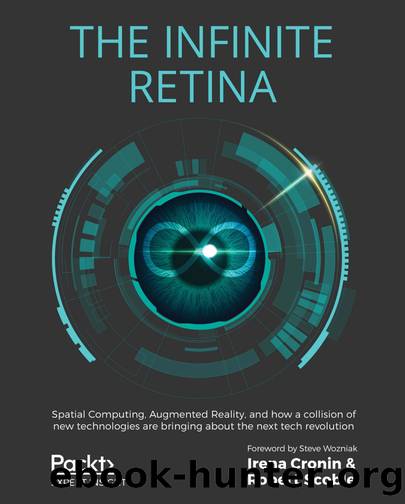The Infinite Retina by Robert Scoble Irena Cronin

Author:Robert Scoble, Irena Cronin
Language: eng
Format: epub
Publisher: Packt
Published: 2020-05-07T22:09:52+00:00
Augmented Reality Visions and Informed Robots
Within a decade, working in a factory will probably be very different than it is today. Many, if not most, workers will probably be wearing Augmented Reality glasses. They will be working with a lot more robots and will be guided by a connected system that will track everything, including machines, humans, robots, and parts flowing into the factory. Additionally, production itself might be quite different thanks to additive manufacturing (3D printing).
Let's go back to the new devices being worn on the face by many workers. We call them Spatial Computing visors, but others call them Augmented Reality or Mixed Reality glasses or visors or HMDs (Head Mounted Displays). These new displays let you see computing in 3D and all around you. They also include microphones, 3D sensors for your hands, for your eyes, and for the world around the worker, along with sensors inside the devices that track up and down, left and right movement and other things, from a potential heartbeat to the brightness of the room.
On little displays, workers see 3D and 2D images overlaid on top of the real world, or, as optics get better, replacing pieces of the real world. Bruce Dickenson, Vice President and General Manager of Boeing's 767/747 program, commented about Boeing's use of Augmented Reality in their factories: "The cross-functional team working on this technology has made a step-change breakthrough in our quality and productivity by following their passion to pursue a great idea. We don't often see 40 percent improvements in productivity, and I'm convinced that it was a culture of innovation and leaders who are willing to say 'yes' that enabled this idea to come to life."
While today's Spatial Computing devices are big and have low-resolution monitors (which is why you don't see many workers using them for coding or writing reports, for instance), in a decade they will be small and have a much larger field of view, with sensors that will see 100x more points of data than they do today, and with GPUs that are much more powerful.
They will also be connected with wireless systems that'll be 10x or more faster than what we can get today. These glasses will also have eye sensors, which haven't really shipped in devices as of 2019, and will have voice recognition systems that make the Siris and Alexas of 2019 seem pretty stupid indeed, along with hyper-sharp optics that will replace all sorts of physical screens.
"Applying Computer Vision and Augmented Reality tools to the manufacturing process can significantly increase the speed and efficiency related to manufacturing and in particular to the manufacturing of automobile parts and vehicles," Tesla's application for a patent for a future Augmented Reality device reads.
Elon Musk, Tesla's CEO, noted in an interview with Marques Brownlee, technology journalist/YouTube star, that many jobs are still not appropriate for robots because they are too complex or still have too much variability. He pointed to a harness of wires being strung along the roof and sides of the car.
Download
This site does not store any files on its server. We only index and link to content provided by other sites. Please contact the content providers to delete copyright contents if any and email us, we'll remove relevant links or contents immediately.
| AI & Machine Learning | Bioinformatics |
| Computer Simulation | Cybernetics |
| Human-Computer Interaction | Information Theory |
| Robotics | Systems Analysis & Design |
Algorithms of the Intelligent Web by Haralambos Marmanis;Dmitry Babenko(7852)
Hadoop in Practice by Alex Holmes(5661)
Jquery UI in Action : Master the concepts Of Jquery UI: A Step By Step Approach by ANMOL GOYAL(5514)
Life 3.0: Being Human in the Age of Artificial Intelligence by Tegmark Max(4509)
Functional Programming in JavaScript by Mantyla Dan(3723)
The Age of Surveillance Capitalism by Shoshana Zuboff(3424)
Big Data Analysis with Python by Ivan Marin(3015)
Blockchain Basics by Daniel Drescher(2891)
The Rosie Effect by Graeme Simsion(2708)
WordPress Plugin Development Cookbook by Yannick Lefebvre(2603)
Hands-On Machine Learning for Algorithmic Trading by Stefan Jansen(2519)
Applied Predictive Modeling by Max Kuhn & Kjell Johnson(2480)
Dawn of the New Everything by Jaron Lanier(2438)
Test-Driven Development with Java by Alan Mellor(2393)
The Art Of Deception by Kevin Mitnick(2299)
Data Augmentation with Python by Duc Haba(2239)
Rapid Viz: A New Method for the Rapid Visualization of Ideas by Kurt Hanks & Larry Belliston(2195)
The Infinite Retina by Robert Scoble Irena Cronin(2183)
Human Dynamics Research in Smart and Connected Communities by Shih-Lung Shaw & Daniel Sui(2178)
